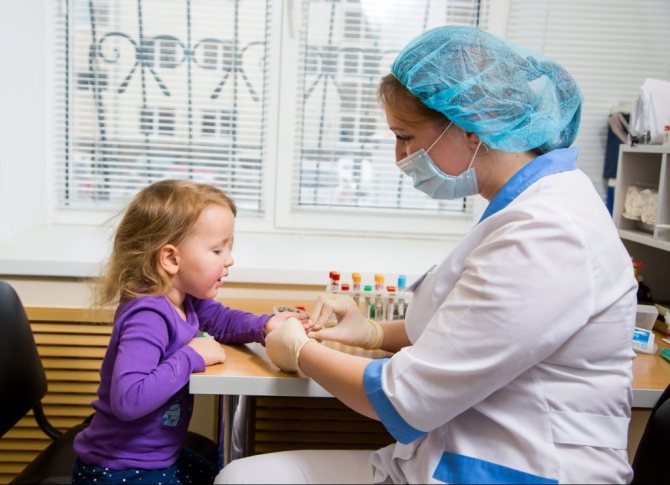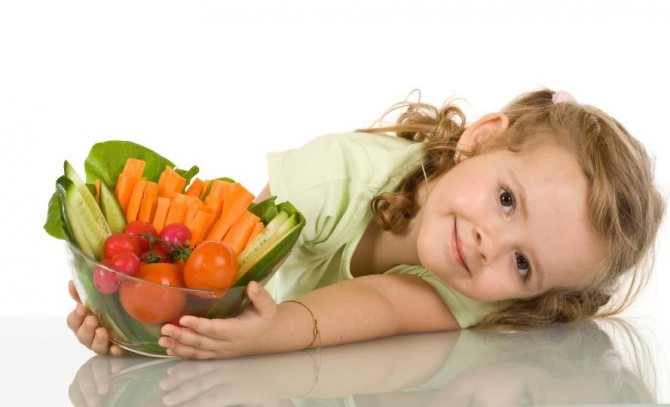The manifestation of pain in the abdominal area can bother children at any age. It is important to determine the cause of its occurrence, since it may not be a simple malaise, but the development of a serious pathology. For diagnosis, the doctor prescribes a series of studies, based on the results of which a conclusion is made.
Abdominal pain in childhood is common
Causes of pain syndrome
There are many factors that provoke abdominal pain in a child. Each of them is characterized by the manifestation of special symptoms.
Ulcer and gastritis
If you are bothered by dull pain that periodically appears and then subsides, this may be a signal of an ulcer. Additionally, nausea occurs. Temperature may rise at times.
Constipation and diarrhea
In childhood, intestinal upset accompanied by pain is a common occurrence. This does not always indicate the development of pathology. Both diarrhea and constipation can occur due to emotional stress and poor nutrition. The child should be seen by a doctor if the problem lasts for several days.
Important! If we are talking about intestinal disorder in a newborn, consultation with a pediatrician is urgently necessary.
Infections
Stomach pain in a child can be caused by a viral infection. In such a situation, additional symptoms will appear in the form of stool disturbances, vomiting, and increased body temperature.
helminthic infestations
Infection with parasites causes pain, accompanied by increased gas formation and itching in the anus, which intensifies at night.
Dyspeptic disorders
When difficulties arise in digestion, the child feels discomfort in the stomach and a feeling of fullness. At the same time, he quickly gets full.
Intestinal obstruction
A phenomenon that most often worries babies from five to nine months. Additional symptoms include bloody stools and nausea and vomiting. This condition requires urgent surgical intervention.
Flatulence and colic
Parents of newborns often experience anxiety in their baby due to colic. This can be understood by their behavior: the child screams loudly, pulls up his legs, and constantly tenses. Older children may experience flatulence, which is not an independent pathology. Increased levels of gas formation appear as a symptom in many diseases.

One of the common causes of abdominal pain in newborns is colic.
Diagnosis of diseases by symptoms
To understand what first aid can be provided to a child for abdominal pain, you should conduct a self-diagnosis based on the symptoms. This will also help provide the doctor with more accurate information about the baby's condition.
In the navel area
Pain in the navel area in a child can be associated with various diseases. If a baby under 6 months of age has a stomach ache, it is most often due to the accumulation of gases, which cause intestinal colic. In babies over 6 months of age, abdominal discomfort is often caused by the introduction of complementary foods. In this case, stool upset and frequent regurgitation may additionally occur. Overeating leads to the same consequences. Pain in the navel area in children over 7 years of age can be caused by viral infections. When infected, the body temperature rises, as well as a runny nose, severe headache and redness of the throat. In children of senior school age, pain in the navel area can often indicate the development of cystitis or pyelonephritis. Additional symptoms for such pathologies are pain when urinating and changes in the color of urine.
Stomach pain, headache, fever
When a child has a stomach ache along with a headache and fever, this is often a sign of an acute respiratory viral infection. Such symptoms may also indicate inflammation of the lymph nodes caused by a variety of diseases. Timely diagnosis will prevent complications. An increase in temperature sometimes causes an acute attack of appendicitis. In this case, pain in the abdomen is most often localized on the right side.
Symptoms of stomach pain
Children's stomach pains, what to do if everything in your child hurts
Children may exhibit additional symptoms. These include:
- lethargy, drowsiness;
- lack of appetite;
- Bad mood.
Depending on the pathology causing the pain, children may experience heartburn, constipation, fever, nausea and vomiting.
In medicine, there are several types of pain:
- aching;
- stupid;
- sharp.
The latter type is one of the most dangerous, as it manifests itself during the development of the inflammatory process of the intestines. Most often this is a sign of appendicitis or pancreatitis.

If sharp pain occurs, it is necessary to immediately show the child to a doctor.
When you urgently need to call a doctor or an ambulance
An ambulance or a doctor should always be called if a child experiences acute abdominal pain. You cannot try to remove it yourself. This can worsen the condition and complicate further diagnosis. In addition, the help of specialists is needed when protective muscle tension occurs when touching the child’s stomach.
A dangerous symptom that should be a reason to call an ambulance is severe vomiting, which does not bring relief. It may be accompanied by diarrhea, in which traces of blood are found, as well as an increase in body temperature. You should also seek medical help when dull or nagging abdominal pain persists for several hours. It is especially dangerous if such a symptom is accompanied by inappropriate behavior of the baby, apathy or fainting.
Diagnosis of gastrointestinal tract disorders
Why does a child have pain in the lower abdomen on the right, left, below the navel?
If your child has stomach pain very often or has additional symptoms such as fever, diarrhea or vomiting, you should consult a doctor. To determine the cause, the following are prescribed:
- general analysis of blood, urine and feces;
- Ultrasound of the abdominal cavity;
- x-ray with catheter insertion.
The specialist also performs palpation. Based on the results of the study, a conclusion is made about the cause of the pain.

To make a diagnosis, the child is prescribed laboratory tests.
Volvulus in children
Intestinal volvulus is one of the forms of obstruction in which part of the loops of the small or large intestine, together with the mesentery, rotates around the longitudinal axis. The cause of volvulus is malformations of the small or large intestine (incomplete rotation, dolichosigma, megadolichocolon, Hirschsprung's disease). Necrosis of intestinal loops and peritonitis develop rapidly.
Symptoms and signs of volvulus in children
The disease begins suddenly. Severe cramping pain is localized near the navel or in the epigastric region. Feces and gases do not pass. Soon frequent vomiting mixed with bile appears. The abdomen is evenly swollen, and muscle tension is felt upon palpation. Violent intestinal peristalsis (during auscultation of the abdomen) quickly fades away. The pulse is frequent, weak in filling, and there is a discrepancy between the pulse and body temperature. An X-ray examination of the abdominal cavity reveals Kloiber's cups, typical for obstruction. Differentiate with other forms of intestinal obstruction.
Treatment is surgical.
Recommendations for pain in children
It is important for parents to know what to do if their child has a stomach ache. It is not recommended to attempt treatment on your own - this may cause complications.
How to help a baby with colic
Abdominal cramps in a child, what to do with intestinal colic
If we are talking about a newborn baby whose tummy hurts due to colic, he can be given Espumisan. Heat on the abdominal area has a good effect: you can use a heated diaper or a salt heating pad.
When an ambulance is needed
If the stomach hurts, without stopping for several hours, and the child has accompanying symptoms in the form of rashes, vomiting, diarrhea, you need to call an ambulance.
Important! Parents should closely monitor the patient's condition. You cannot miss the appearance of pallor, high fever, vomiting and nausea - they can be a manifestation of a dangerous disease.
Rest mode
Rest plays an important role for a sick child. He needs to be put to bed. If vomiting occurs, it is best to lay it on its side so that the baby does not choke.
If there is pain in the abdominal area, it is necessary to limit the child from lifting anything heavy. In a situation where he attends sports clubs, stop exercising until the cause of the pain is identified.
Diet food
If necessary, a pediatrician can develop a diet plan. Most often it includes:
- vegetable soups in broth without meat;
- liquid porridge with water;
- steamed vegetables;
- lean fish;
- baked fruits;
- homemade jelly;
- herbal teas.
All sweets, pasta, pastries, grapes, cabbage, sausages, and potatoes are prohibited. These foods can be eaten in limited quantities as soon as the exacerbation is relieved.

Proper nutrition plays an important role
The most common causes of tummy pain in children
Children very often complain of abdominal pain, but they cannot always indicate their location and nature. This makes diagnosis much more difficult. Therefore, it is very important to learn how to determine the location of pain by analyzing the child’s behavior. This will allow you to provide timely first aid to the baby.
Poisoning
Most often, abdominal pain in a child can occur due to poisoning. In this case, painful sensations can be of varying intensity and nature. Poisoning with low-quality products is usually accompanied by indigestion. The first symptoms, such as diarrhea and vomiting, appear within a few hours after eating. In addition, the temperature may rise, lethargy and apathy appear. The baby turns pale and his lip color changes. In severe cases, poisoning with poisons and medications can cause heart rhythm disturbances and loss of consciousness.
Preventive measures
Nutrition plays an important role in the proper functioning of the gastrointestinal tract. This problem is especially acute for primary school students. To avoid stomach problems, it is recommended to follow a number of preventive measures:
- Maintain a drinking regime and completely eliminate carbonated drinks.
- Reduce consumption of spicy, fatty, smoked and fried foods.
- Create a regular meal schedule for your child. It should consist of a full breakfast, lunch and dinner.
Personal hygiene, washing hands, vegetables and fruits before eating are of no small importance.
Attentive attitude towards the child and monitoring his condition will help solve the problem with pain in the stomach as quickly as possible.
Prevention of abdominal pain in children
Prevention of abdominal pain in a child is primarily associated with the normalization of nutrition and eating patterns. In order to improve the digestion process, it is important to include fermented milk products in your baby’s diet. It is also necessary to ensure that the child’s body receives all the necessary vitamins and minerals. The quality of food consumed by the child should be strictly controlled.
A prosperous family environment reduces the risk of abdominal pain in a child. It is important to strive to protect your baby from stress and nervous strain. They are dangerous at any age and can cause disruptions in the body. If you detect any problems with the digestive organs, you should definitely consult a gastroenterologist. Timely treatment will avoid serious complications.
Factors that provoke discomfort
The digestive system of minors is more unstable than that of adults. This is due to the fact that the gastrointestinal tract is sensitive to the effects of various circumstances. Factors that are common explanations for why a child’s lower abdomen hurts include:
- Wrong diet. Abuse of food containing large amounts of carbohydrates and proteins disrupts the functions of the stomach and intestines. The child develops flatulence, nausea, and discomfort in the peritoneal area. The lack of useful microelements also negatively affects the state of the gastrointestinal tract.
- Insufficient fluid intake. A small amount of water causes stool retention. Therefore, there is a situation in which the child’s lower abdomen hurts.
- Ignoring hygiene standards. Unwashed hands are sources of helminths and germs.
- Features of the structure of the gastrointestinal tract.
- Individual food intolerance.
- Mechanical damage to the peritoneum.
- Emotional stress.
- Sedentary lifestyle.
- Disorders of the gastrointestinal tract (gastritis, inflammatory process in the pancreas and intestines, cholecystitis).
Peritonitis in children
Peritonitis develops primarily or becomes a consequence of perforation of the intestinal wall due to its obstruction of various origins.
Symptoms and signs of peritonitis in children
Pain throughout the abdomen, worsening when trying to breathe deeply or cough; general hyperesthesia of the abdominal skin. The abdominal wall is not involved in breathing. The abdomen gradually swells due to flatulence from paresis of peristalsis, and the passage of gases and feces stops. An important sign is persistent vomiting mixed with bile. The pulse is rapid, thread-like.
Treatment is surgical.
Prevention
There are no specific measures to prevent stomach pain in a child, but parents only need to:
- monitor what the child eats;
- competently use medications to treat other ailments;
- ensure a healthy and active lifestyle for your children;
- protect from stressful situations;
- normalize the sleep and wakefulness of children.
It is very important that the child regularly and promptly undergoes all necessary medical examinations.
Stomach pain in a child never occurs for no reason. Complaints of abdominal pain may be the first signals of possible disturbances in the functioning of the gastrointestinal tract and attention should be paid to this immediately.
If abdominal pain is accompanied by nausea, vomiting or fever, you should immediately consult a doctor. Today we will look at the most common reasons why a child has a stomach ache and find out what can be given, what to feed a child with abdominal pain, and also which doctor to contact for treatment.










